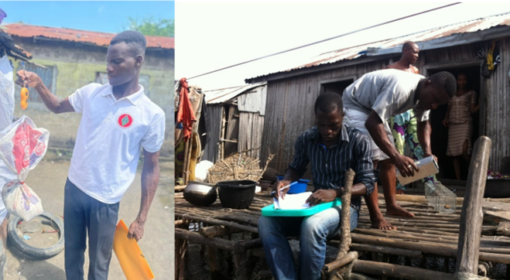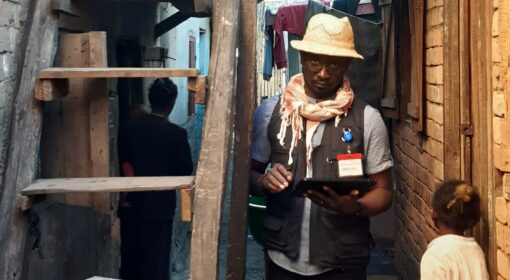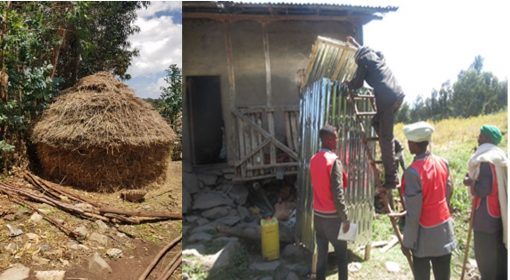Authors: Lucía Moreno Spiegelberg, Joël Dossou, Jonas Etougbétché, Luwieke Bosma
Pour la version en français, cliquez ici.
We stretch our tender leaves, and we cover the water, all of it. We crowd in the soft shores and the open waters, disputing the territory to the cans and plastic bags. As we grow among the houses and the canoes, you might believe they float on a green meadow. But they are sustained on an exhausted lake, bloated from drinking the city’s water, blinded by the shade of our leaves. Now and then, the rain stops, and the freshwater retreats, letting the sea in, and we die once again, sinking to the bottom, waiting for the rain.
The city of Cotonou is surrounded by water. It stands on a strip of alluvial sand that stretches from west to east, separating Lake Nokoué from the Atlantic Ocean. The rain accumulates on both sides of the city, forming swamps, and the water of Lake Nokoué retreats and grows, flooding parts of the city (1). Cotonou is divided from north to south into two unequal parts by Cotonou’s Lagune, which connects the lake with the sea, allowing the entrance of salty water during low water periods (2). Lake Nokoué is highly polluted, and its eutrophication becomes visible with the proliferation of invasive species like water hyacinths that die with the water’s salinity fluctuations (2).

Waste management is generally considered to be one of Cotonou’s most pressing environmental problems, especially in areas prone to floods and informal settlements since they are inaccessible to garbage trucks. Hence, much of the city’s solid and liquid waste ends up in the streets or in the water (3). Despite the sanitation problems, these surrounding water bodies support the economy of an important part of Cotonou’s population, as people largely depend on fishing for their income (1).
Lake Nokoué’s fishermen settlements have their origin in the seventeenth century when the lake served as a refuge from clan wars and kidnappings for the slave trade (2). The refugees built villages on stilts, where the water could protect them from their persecutors and provide them with fish (4). Eventually, some of these peoples arrived at Cotonou’s shore and established small fisherman settlements that escaped the vigilance of the city’s authorities. Accompanying the rapid urbanization of the western coast of Africa, the settlements also grew together, forming what is now known as Ladji.
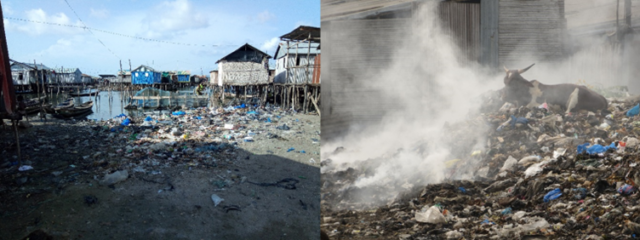
The houses of Ladji are distributed anarchically, with houses on the ground (that only sometimes get flooded) and houses on stilts that stretch from the dryland to the depths of the lake. The population is very poor and builds their houses with improvised materials like metal sheets or plant-based materials. The homes generally have many openings, allowing rodents to come and go. The presence of trash makes Ladji a perfect environment for rodents and shrews. In fact, the researchers identified an infestation rate of almost 86% of Ladji houses, where black rats and the African giant shrew were the most abundant species. These small mammals are not intimidated by the surrounding water, and in fact, they can swim; black rats, for instance, can swim up to 300m.
An exploratory study carried out by the researchers of the Abomey-Calaby University has showed that the presence of these small mammals leads to different problems for the population. Thus, residents report damage to domestic materials, stored food, and clothes. These property damages constitute a detriment not only for the domestic economy but also for the food-trading activities, the main occupation of Ladji’s women. In Ladji’s houses, the estimated losses of maize to the small mammals are approximately half a kilo per week, which is 25% of their reserves since Ladji’s population don’t storage big quantities of maize.

In addition to their negative effect on the local economy, the small mammals of Ladji carry several pathogens that can be transmitted to humans, such as Leptospirosis, Bartonella, Toxoplasma, antibiotic-resistant enterobacteria, etc. The health hazards they pose contrast with the population’s attitude towards them since the consumption of black rats is normalized or even associated with supposed healing properties, like alleviating asthma symptoms. These observations highlight the importance of a One Health approach, as it relates not only to health but also to socio-cultural and economic aspects, which are essential to address the higher risk of epidemics in anthropized areas where living conditions are precarious.
To confront this, the SCARIA project team has gathered multiple actors and disciplines comprising scientists, health workers, and residents, among others. Scientists from the SCARIA project have been collecting data from small mammals related to diversity and abundance, habitat characterization, and the prevalence of rodent-borne zoonotic pathogens, and relationships with humans. They have also created a youth group in the community: “club jeune opérationnel local” (CJOL). Eight dynamic young people constituted this group, who facilitated communication between the inhabitants and scientists.
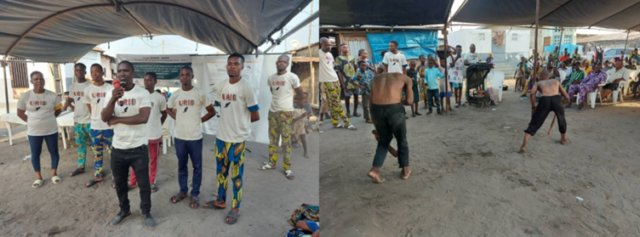
A local committee was also established to co-build an EBRM strategy adapted to Ladji’s context. To do so, we organized several discussion sessions with a committee composed of different stakeholders: local communities and their representatives (district leader and its consultants, representants of women and young associations, representants of cultural and religious associations), ONG, and community services. At the end of these meetings, it was decided to introduce predators, especially cats, to those who wish, to clean periodically around the houses and to use multiple capture traps. However, the residents of Ladji had concerns about the costs of these measures and handling the rodents themselves. Currently, the project team takes up this responsibility and guides the residents on the steps. We are carefully developing the community’s involvement in rodent management in very dense urban settings, such as slums. It is one of the biggest challenges we are taking on, as the social dynamics differ highly J’ai un peu modifié la structure du texte et ajouté quelques éléments afin de répondre un peu mieux aux questions de Luwieke. from rural settings. However, through many interactions, discussions, and campaigns, we are learning a lot about this process, and the cross-overs between multi-level interdisciplinary actors prove vital in this regard.
The population of Ladji had the explicit whish to manage the small mammals despite the imposibility of expending their time and money on them. This is why in future steps of the SCARIA project it is planned to train the CJOL in rodent handling so that they can support the management measures decided by the community. Complementarilly, periodic sanitation campaigns will be performed in the future, and the involvement of the community will be enhanced through aware-raising campaigns.
The SCARIA team already organized the first awareness-raising session at Ladji in which they presented the results of their research and had enriching discussions with the communities. To attract the community’s attention, the project team made the event festive with sketches, dances, and songs about rodents and how to manage them. The song’s lyrics explained the rodents’ characteristics and how to manage them. The festive and lively ambiance of the event made it very engaging and successful, being a solid base for future activities in the area.
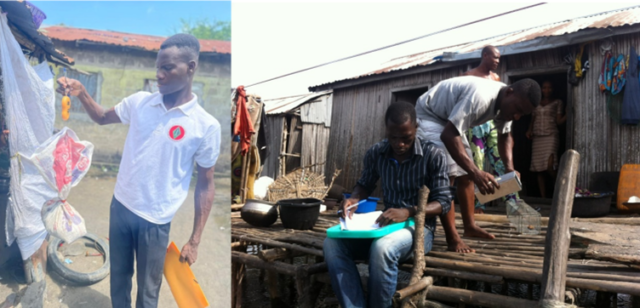

REFERENCES
- Dossou, K. M., & Glehouenou-Dossou, B. (2007). The vulnerability to climate change of Cotonou (Benin) the rise in sea level. Environment and Urbanization, 19(1), 65-79.
- Djihouessi, M. B., & Aina, M. P. (2018). A review of hydrodynamics and water quality of Lake Nokoué: Current state of knowledge and prospects for further research. Regional Studies in Marine Science, 18, 57-67.
- Brock, B., & Foeken, D. (2006). Urban horticulture for a better environment: A case study of Cotonou, Benin. Habitat international, 30(3), 558-578.
- Soumonni, E. (2003). Lacustrine villages in south Benin as refuges from the slave trade. Fighting the slave trade: West African strategies, 38, 1.
